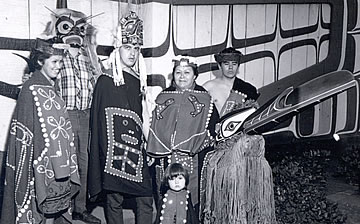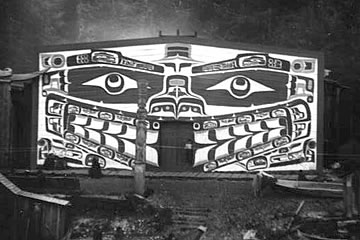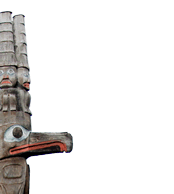 |
|||||||||
 |
|||||||||
 |
|||||||||

Image Gallery
|
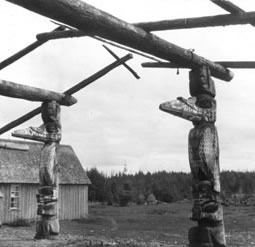 Tsaxis
(Fort Rupert), 1904. Charles F. Newcombe photograph. RBCM PN 372. Tsaxis
(Fort Rupert), 1904. Charles F. Newcombe photograph. RBCM PN 372. |
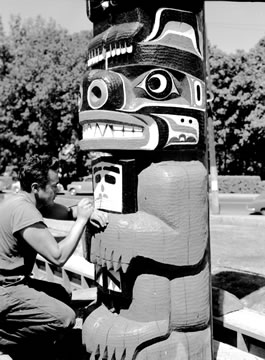 David
Martin painting a front house post in Wawadiťła, 1953. BC Government
photograph. BC Archives I-26985. David
Martin painting a front house post in Wawadiťła, 1953. BC Government
photograph. BC Archives I-26985. |
||||||||||
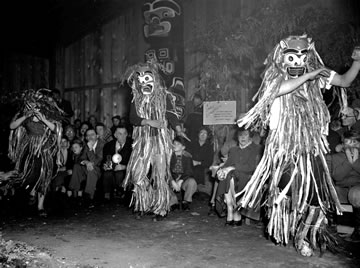 Ceremonies
at the opening of Wawadiťła, 1953. BC Government photograph. BC
Archives I-26809. Ceremonies
at the opening of Wawadiťła, 1953. BC Government photograph. BC
Archives I-26809.
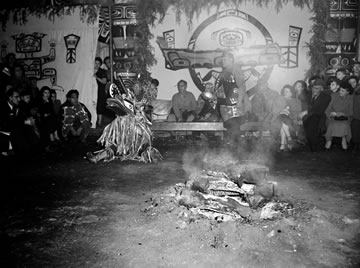 Ceremonies
at the opening of Wawadiťła, 1953. BC Government photograph.
BC Archives I-26823. Ceremonies
at the opening of Wawadiťła, 1953. BC Government photograph.
BC Archives I-26823. |
Traditionally, potlatches were held when new houses were built. These ceremonies established the right of the owner to use and display the hereditary elements in the house, such as the posts and other carvings. Appropriately, the new house in Thunderbird Park was opened in December 1953 with a potlatch ceremony. Many ranking hereditary chiefs of the Kwakwaka'wakw and other First Nations were present on this historic occasion. It was the first legal public potlatch since the 1884 Canadian government prohibition on potlatching was dropped from the Indian Act in 1951. Mungo Martin’s only son, Hinak´alasu (David Martin), died in a fishing accident in 1959. After Martin’s death in 1962, the traditional hereditary rights to Wawadiťła passed to Martin’s grandson, Chief Oasakalagalis ‘Walas ‘Namugwis (Peter Knox of Fort Rupert). Since its opening in 1953, Wawadiťła has been used for hundreds of First Nations events with the permission of Peter Knox and his wife, Mable. |
||||||||||
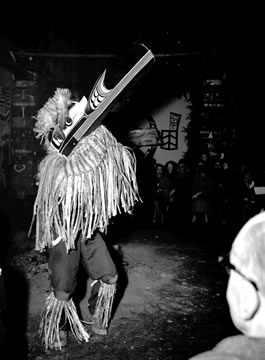 Ceremonies at the opening of Wawadiťła, 1953. BC Government photograph.
BC Archives I-27006. Ceremonies at the opening of Wawadiťła, 1953. BC Government photograph.
BC Archives I-27006. |
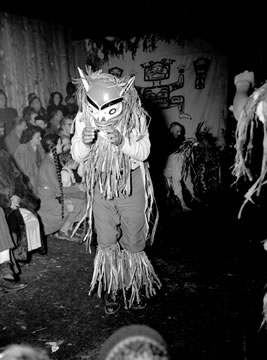 Ceremonies
at the opening of Wawadiťła, 1953. BC Government photograph. BC Archives
I-27012. Ceremonies
at the opening of Wawadiťła, 1953. BC Government photograph. BC Archives
I-27012. |
||||||||||
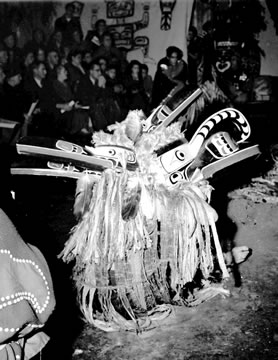 Ceremonies
at the opening of Wawadiťła, 1953. BC Government photograph. BC Archives
I-27007. Ceremonies
at the opening of Wawadiťła, 1953. BC Government photograph. BC Archives
I-27007. |
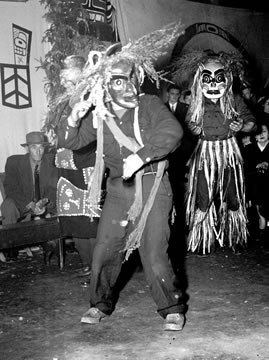 Ceremonies at the opening of Wawadiťła, 1953. BC Government photograph.
BC Archives I-27009. Ceremonies at the opening of Wawadiťła, 1953. BC Government photograph.
BC Archives I-27009. |
||||||||||
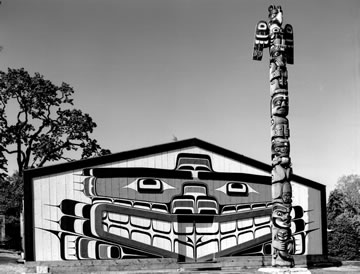 Thunderbird
Park, 1953. BC Government photograph. BC Archives I-26804. Thunderbird
Park, 1953. BC Government photograph. BC Archives I-26804. |
House Frontal Painting - C'i'eqis, a supernatural sea creature shaped like a bullhead or sculpin, is a crest that belonged to an uncle of Mungo Martin. A version of it can be seen in historical photographs of a house at Tsadzis'nukwaame' (New Vancouver) on Harbledown Island. There are similarities, too, with the frontal painting of a dwelling known as Sea Monster House in the village of Gwa'yasdams on Gilford Island. Mungo Martin had ties to that village as well: his father was from Gwa'yasdams and the first house frontal pole Martin carved was erected in front of Sea Monster House. Anthropology Curator Wilson Duff explained that Martin ‘borrowed’ a house frontal painting because the house he recreated did not have one. The interior houseposts and
other objects in Wawadiťła depict the same creatures
as those of the original house. They are crests of the families to
which Mungo Martin was related by heredity or by marriage. Crests
represent ancestors or supernatural beings encountered by ancestors.
They are family property and indicate the names, rights, responsibilities
and family histories of those who have the right to use them. |
||||||||||
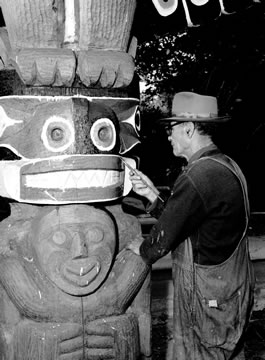 Mungo Martin
painting a rear house post in Wawadiťła, 1953. BC Government photograph. Mungo Martin
painting a rear house post in Wawadiťła, 1953. BC Government photograph.
BC Archives I-26984. |
|||||||||||
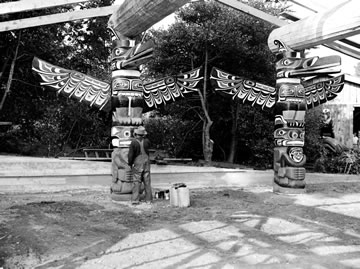 Thunderbird
Park, 1953. BC Government photograph. BC Archives I-26803. Thunderbird
Park, 1953. BC Government photograph. BC Archives I-26803. |
Houseposts, rear of house - Huxwhukw, a companion of the cannibal Baxwbakwalanuxwsiwe', the supernatural spirit associated with the prestigious Hamatsa winter dance ceremony. It is the main crest of the Gixsam lineage of the Kwagu’ł. The birds’ beaks are hinged and can be made to open and shut. Grizzly Bear, a crest of the Wa'walibui lineage. |
||||||||||
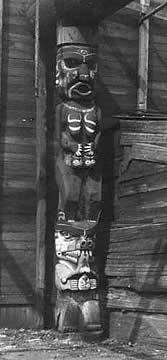 Tsaxis
(Fort Rupert), 1904. Charles F. Newcombe photograph. RBCM PN 373. Tsaxis
(Fort Rupert), 1904. Charles F. Newcombe photograph. RBCM PN 373. |
Houseposts, front of house -
Dzunuk´wa,
a mythical wild woman who lives in the forest and is feared because
she steals children. She is a sleepy, slow-moving giantess whose round
mouth and protruding lips indicate her characteristic cry: ‘Hu,
Hu, Hu’.
This is a crest of the Kwikwasutinuxw people
of Gilford Island. Grizzly Bear, a crest of the Wa'walibui lineage. |
||||||||||
| Walls - Sisiyutł, a supernatural double-headed serpent. This powerful being, the blood of which can turn people to stone, is a 'Namgis crest. The Sisiyutł image on the entrance wall was acquired in 1913 by Charles F. Newcombe either at the ?awi?sis village of Kalugwis on Tournour Island or at the ‘Namgis community of ‘Yalis (Alert Bay). In 1941, it was attached to the façade of a building in Thunderbird Park where canoes were displayed. The Sisiyutł carvings on the side walls were painted for the house in 1960 by Mungo Martin and Henry Hunt. | |||||||||||
| Back to Wawadiťła |

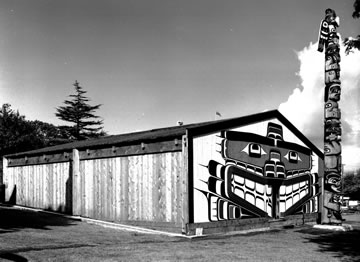 Thunderbird
Park, 1953. BC Government photograph. BC Archives I-26979.
Thunderbird
Park, 1953. BC Government photograph. BC Archives I-26979.